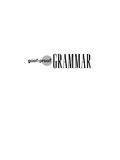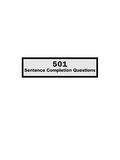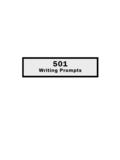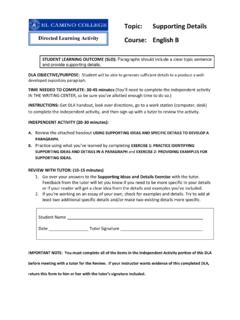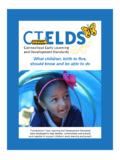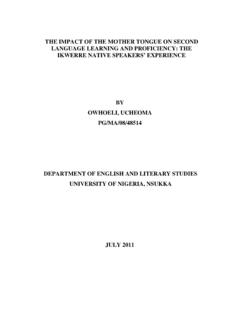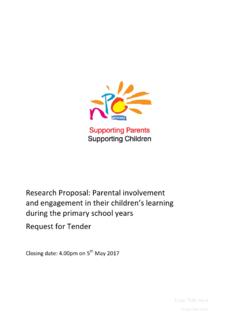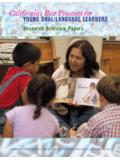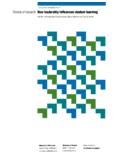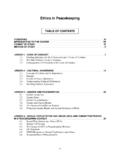Transcription of Oral Language - Macomb Intermediate School …
1 MLPP second Edition/200023 Proof #8 5/09/01 Section IIOral LanguageRationaleThe development of literacy begins through the use of spoken Language . oral Language provides ameans to observe children as they learn to construct conceptual meanings through words. Childrenwho are developing Language appropriately will demonstrate an increasingly complex use of words inexplanations. Comprehension as shown through the production of structural relationship of words inspoken Language will provide indicators of the child s knowledge about meaning and the close relationship between reading and Language , we could expect that children withwell-developed oral Language skills and appropriate instruction will move into printed text oral Language has many functions, most of which occur in a social context, the purpose ofthese assessments are limited in scope.
2 This oral Language assessment relates to children s ability toeffectively use semantic (meaning) and syntactic (function and grammar) cueing systems whilecommunicating to support the learning of reading and writing order to establish instructional priorities for each child in the emergence of literacy developmentthe oral Language assessment is used. These tools help teachers understand what individual childrenknow specifically about speaking and listening to construct and communicate is fluency in speaking and listening. In this document we use the term oral Language whichincludes the expressive(speaking) and receptive(listening) aspects of chart on the following page provides an overview of oral Language assessment in the tool is identified, along with the purpose for the assessment, and the appropriate grade levelfor use of the assessment.
3 This chart is meant as a guide for the teacher s choice of assessment selection of the appropriate assessment is best determined through the teacher s ongoingobservation of students within the classroom second Edition/200024 Proof #8 5/09 all the picture cards to the child and allow her or him to select one. Do not discuss thepictures during this the chosen picture on the table in front of the child and say, Tell me a story about thepicture. Transcribe the child s entire response. You may prompt the child by saying, Tell memore, or What else can you say? Do not ask leading Language SampleFree Recall or Picture PromptOral Language RubricListening ChecklistAssessment Options at second GradeToolsWhat is AssessedAppropriate UsePreschool first gradeGrades 1 3 Grades 1 3 Ability to demonstrate syntaxand complexity of sentences,vocabulary, identification andelaboration of to use expressive lan-guage which communicatesideas, organization and struc-ture, vocabulary, style andvoice, conventions.
4 And non-verbal communication elementsin ways that connect to knowl-edge about text usage in readingand to flexibly use a varietyof listening skills in gainingmeaning from an expressivelanguage presentation of ideas ineither group experiences orindividual Guidelines for Preschool First Grade oral Language AssessmentTeachers will listen to each child in the classroom during informal interactions to determine whichchildren are using oral Language flexibly and readily to understand and express conceptual meaningswith others in the classroom that corresponds with level 3 on the rubric provided (page 29).
5 Children not exhibiting strong oral Language skills [ 3 s on the rubric (page 29) in syntax,vocabulary, and elaboration] should be assessed individually. The assessment area should be quietand free from major distraction. Generally, a small table where the teacher can sit beside the childis second Edition/200025 Proof #8 5/09 the completed transcription using the rubric. For the syntax rubric, you may use thechild s typical speech to assess use of regular and irregular verbs and regular and irregularplurals, if necessary. Write the scores on the paper with the script. Add the child s name anddate of assessment to the scored script, and place it in the child s portfolio.
6 Enter each of thethree scores on the student record the assessment during kindergarten and first grade as appropriate until the child obtainsa score of three, indicating typical performance, on each element of the the child s performance. Ask yourself the following questions as you consider the responsethe child has Does the child use this Language at home or in social situations? Is the child aware that School Language and home Language differ? (Look for play situationswhere the child is playing School .)Vocabulary Is the child using Language that is more familiar and affective? Is the child using Language that is comparative and formal?
7 Is the child able to separate description based on form and function? Elaboration Does the child use analogies and/or metaphors to connect ideas and experiences? Does the child string events or ideas, rather than using categories of ideas and events? Note:Consider if low scores are reflective of a child s typical oral Language , or question whetherpoor performance, at least in part, is due to lack of experience with the content of the pictures?Additional oral Language SampleIf an additional Language sample is indicated when a student s performance lacks consistency withobserved classroom behaviors, consider taping an oral Language sample without a specific pictureprompt.
8 Choose a topic the child has expressed interest in, and provide an open-ended prompt; , Sintenesha, tell me about your birthday party. Using the rubric supplied, score the child s second Edition/200026 Proof #8 5/09/01 PreK First GradeOral Language Sample Scoring RubricSyntax4 -Uses appropriate syntax of the english Language with complex sentences. Regular andirregular plurals and past tenses are used -Uses appropriate syntax of the english Language . Regular plurals and past tenses are usedcorrectly. Irregular forms are -Uses correct english syntax for very simple sentences and inappropriate use of plurals andpast -Uses very little correct syntax of the english Language , and inappropriate use of plurals andpast tenses.
9 May use only present tense, even when prompted. No complete sentences -Uses interesting vocabulary some of the time, including use of descriptive adverbs -Uses basic Language consisting mostly of nouns and verbs with some use of -Uses very simple, basic Language consisting mostly of nouns and verbs with little use -Unable to name some of the elements of the picture. Lack of vocabulary impedes -Relates the elements in the picture while using extensive prior knowledge and past experi-ences. The narrative is substantive and well -Relates the elements in the picture incorporating past experiences and prior -Uses a simple sentence or two while relating the elements in the picture to each -Gives labels for elements in the picture; , boy, house, second Edition/200027 Proof #8 5/09/01 1.
10 Syntax 2. Vocabulary 3. ElaborationOral Language SamplePreschool First GradeIndividual Score SheetStudent _____ Grade _____ Date _____Enter the number of points given to the student after each task. Picture Content Suggestions Check types of pictures used with selectedTSTeacher selectedCSTS School related (children playing with blocks) Home related (children getting into car or on bus, a few adultsand children in a family) Sports related (soccer or basketball game) Pet related (child feeding dog) Chore related (people picking apples) Urban street scene with people of different ages Other describe _____ second Edition/200028 Proof #8 5/09/01 Assessment Guidelines for Expressive Language (Speaking)


